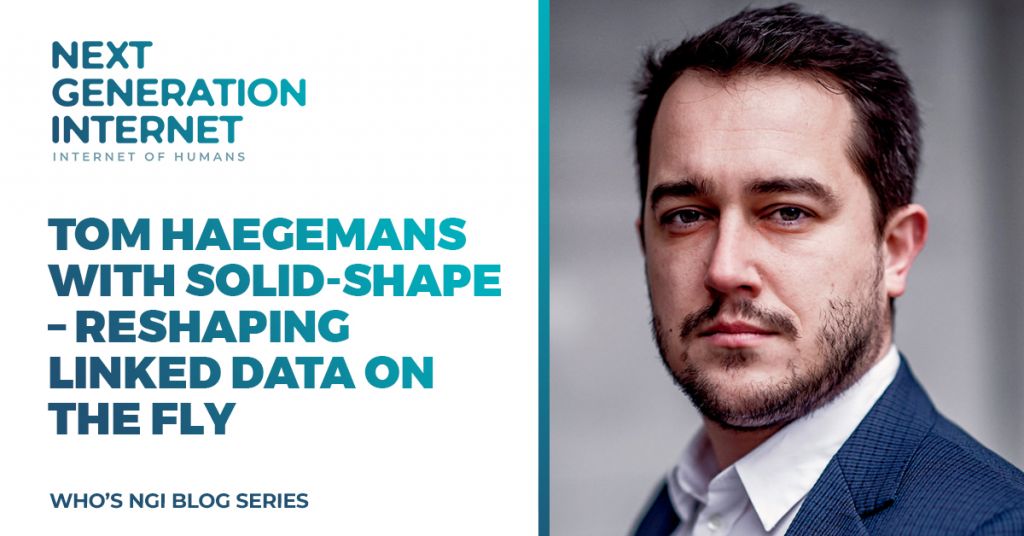How to interconnect personal data across and within organisations without having to enter the same information repeatedly? That’s the issue that Solid-Shape is tackling. Tom Haegemans explains more.
What problem does your project solve?
In this day and age, a person’s data is typically scattered across different organisations where it is most likely stored in separate systems in the form of multiple copies of the same data.

Sadly, this common way of handling personal data has several issues for both the person who is the data owner and for organisations that handle this data. For people like you and me, the fact that many organisations store a copy of exactly the same data means that you can quickly lose sight of where this data is stored, what is done with it and can therefore also not control what happens with it. For organisations, it is not only hard to manage multiple copies of this data, but also to keep each of those copies up-to-date. Moreover, every time a person needs to provide his or her data to a new organisation, the situation gets only worse. The person will probably need to enter the exact same data that s/he has provided to other organisations before and there will be yet another copy at yet another organisation that needs to be kept up-to-date.
One way to resolve these issues is to interconnect personal data across systems and organisations so that a person can easily reuse data from one organisation at another and organisations have a way to trace back copies to their authentic source. This way, people can get an overview of where their information is stored and organisations can have a way to keep their copy up-to-date.
Currently, data systems are typically interconnected using API’s or Application Program Interfaces. However, organisations typically use different rules to format and structure their APIs so that these APIs only allow for a certain amount of interconnectivity.
In order to truly interconnect personal data across and within organisations, systems need to be made interoperable. In other words, they need to follow certain agreed upon rules so that all of them – current and future ones – speak the same language.
Could you explain in simple terms what is new and original in your project?
Solid is such a set of rules: it is an open (draft) W3C standard or, in other words, a protocol that several parties have agreed upon. The Solid protocol leads to a Solid-based ecosystem like the world wide web, but then for personal data. Sometimes, this ecosystem is called “the personal data web”.
The most fundamental rules of the Solid specification state that a personal data web consists of pods and apps. The rest of the Solid rules state how these pods and apps should talk to each other. According to the rules, a pod (i.e. personal online datastore) is a place to store things, with mechanisms for controlling who can access what. An app is an application that reads or writes from one or multiple pods.
The value of Solid for organisations, and thus Digita’s customers, lies in the fact that they will have it easier to
- connect distinct user interfaces (i.e. apps) with distinct digital vaults (i.e. pods);
- make data available for a person so that s/he can reuse this data at other parties;
- allow a person to reuse his or her data that other parties made available for him or her and
- create a decentralised social network
because, eventually, their systems and strategic partners will all follow the same rules.
How did NGI support your idea?
The support of NGI was and still is paramount to the success of Digita and even Solid. Over the years, we have noticed that several essential parts were missing from the Solid ecosystem in order for it to be actually adopted by large enterprises (e.g. a legal framework, a registry of semantic components and a way to enable trust). At the same time, we noticed that many of those missing parts should, in fact, be open sourced so that they are available to other actors in the ecosystem as well. However, because of the open source nature and lack of commercial potential, it was nearly impossible to get those parts funded by private investors.
Digita is a start-up I co-founded that builds software and provides services for organisations that want to take part in the Solid ecosystem. The centerpiece of our products is Digita Connect: a middleware solution to connect Solid pods to the legacy systems of organisations. Our customers include governments and financial service providers. In 2020, we won the Brussels Innovative Starters Award and €500,000, we were selected for the NGI DAPSI Accelerator, we were awarded an NGI Pointer grant and now, we are about to participate in the NGI Ontochain programme.
Fortunately, the NGI grants enable us to investigate and build those parts that were lacking – the legal framework, semantic components registry and a way to enable trust – so we can make them freely available to the community. As a European citizen, I am proud that the NGI project provides us with the required resources and thus plays an important part in launching the Solid ecosystem and giving people more control over their personal data.
Access the repository of solid-shape (aka semcom): https://github.com/digita-ai/semcom
Access UI-transfer from DAPSI: https://github.com/digita-ai/ui-transfer
Tom Haegemans is Co-Founder and Research Lead of Digita and Research Fellow at the University of Leuven For more information about Digita:
- https://digita.ai
- https://www.youtube.com/channel/UCA22hu-0VEHt5tCc7jad74g
- https://www.linkedin.com/company/digita-ai
- https://twitter.com/Digita_AI


